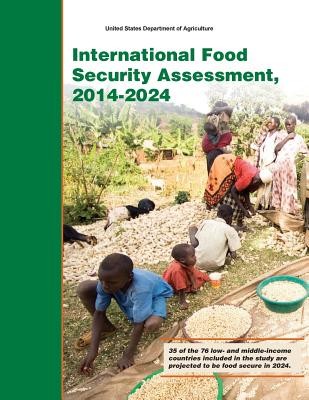
- We will send in 10–14 business days.
- Author: United States Department of Agriculture
- Publisher: CreateSpace Independent Publishing Platform
- Year: 2014
- Pages: 50
- ISBN-10: 1505433649
- ISBN-13: 9781505433647
- Format: 21.6 x 27.9 x 0.3 cm, softcover
- Language: English
- SAVE -10% with code: EXTRA
International Food Security Assessment, 2014-2024 (e-book) (used book) | bookbook.eu
Reviews
Description
Food insecurity in the 76 countries included in this report (low- and middle-income countries as classified by the World Bank that are or have been receiving food aid and are experiencing or have experienced food insecurity) is expected to remain virtually unchanged, but with some distributional changes, between 2012 and 2013. The total number of food-insecure people is estimated at 707 million in 2013, up 3 million from 2012. Over the longer term, the food security situation is projected to deteriorate. Food-insecure people are defined as those consuming less than the nutritional target of roughly 2,100 calories per day per person. By 2023, the number of food-insecure people is projected to increase nearly 23 percent to 868 million, slightly faster than population growth. As a result, the share of the population that is food insecure is projected to increase from 20.4 percent to 21.5 percent. The distribution gap-the amount of additional food needed to bring people in all income deciles up to the nutritional target-is projected to increase 28 percent by 2023, meaning that food insecurity in these countries is expected to intensify over the next 10 years. Despite improvements over the years, Sub-Saharan Africa is projected to remain the most food-insecure region in the world.
EXTRA 10 % discount with code: EXTRA
The promotion ends in 18d.16:10:41
The discount code is valid when purchasing from 10 €. Discounts do not stack.
- Author: United States Department of Agriculture
- Publisher: CreateSpace Independent Publishing Platform
- Year: 2014
- Pages: 50
- ISBN-10: 1505433649
- ISBN-13: 9781505433647
- Format: 21.6 x 27.9 x 0.3 cm, softcover
- Language: English English
Food insecurity in the 76 countries included in this report (low- and middle-income countries as classified by the World Bank that are or have been receiving food aid and are experiencing or have experienced food insecurity) is expected to remain virtually unchanged, but with some distributional changes, between 2012 and 2013. The total number of food-insecure people is estimated at 707 million in 2013, up 3 million from 2012. Over the longer term, the food security situation is projected to deteriorate. Food-insecure people are defined as those consuming less than the nutritional target of roughly 2,100 calories per day per person. By 2023, the number of food-insecure people is projected to increase nearly 23 percent to 868 million, slightly faster than population growth. As a result, the share of the population that is food insecure is projected to increase from 20.4 percent to 21.5 percent. The distribution gap-the amount of additional food needed to bring people in all income deciles up to the nutritional target-is projected to increase 28 percent by 2023, meaning that food insecurity in these countries is expected to intensify over the next 10 years. Despite improvements over the years, Sub-Saharan Africa is projected to remain the most food-insecure region in the world.


Reviews